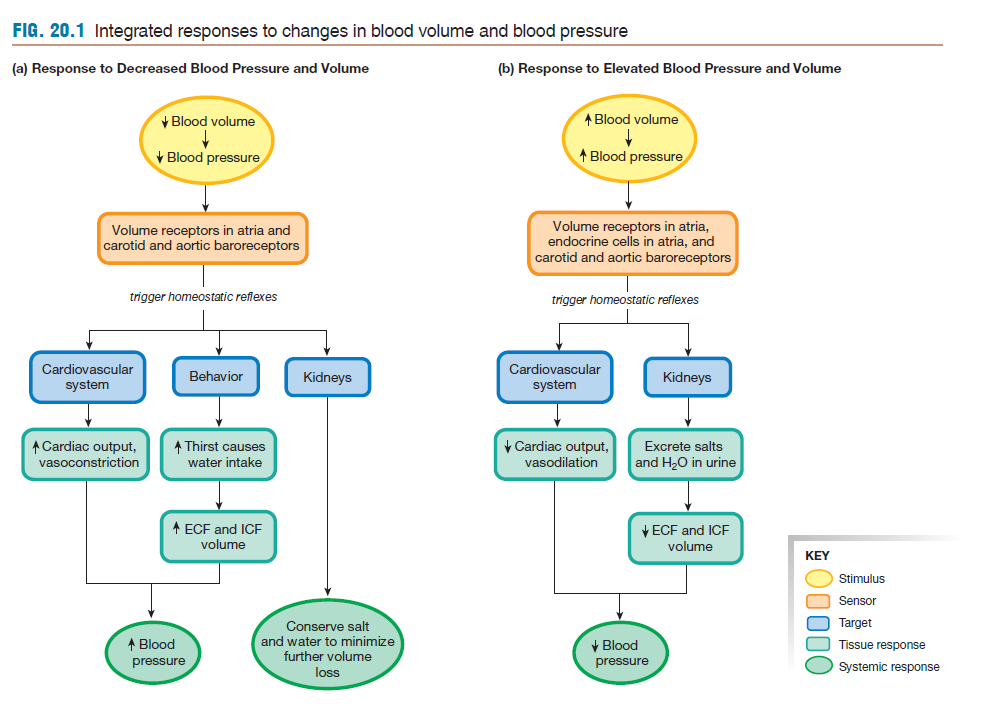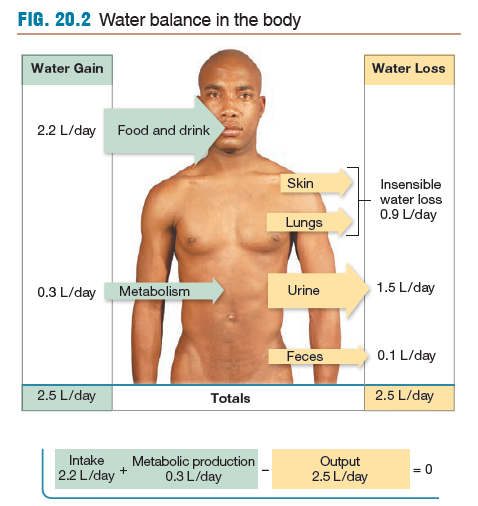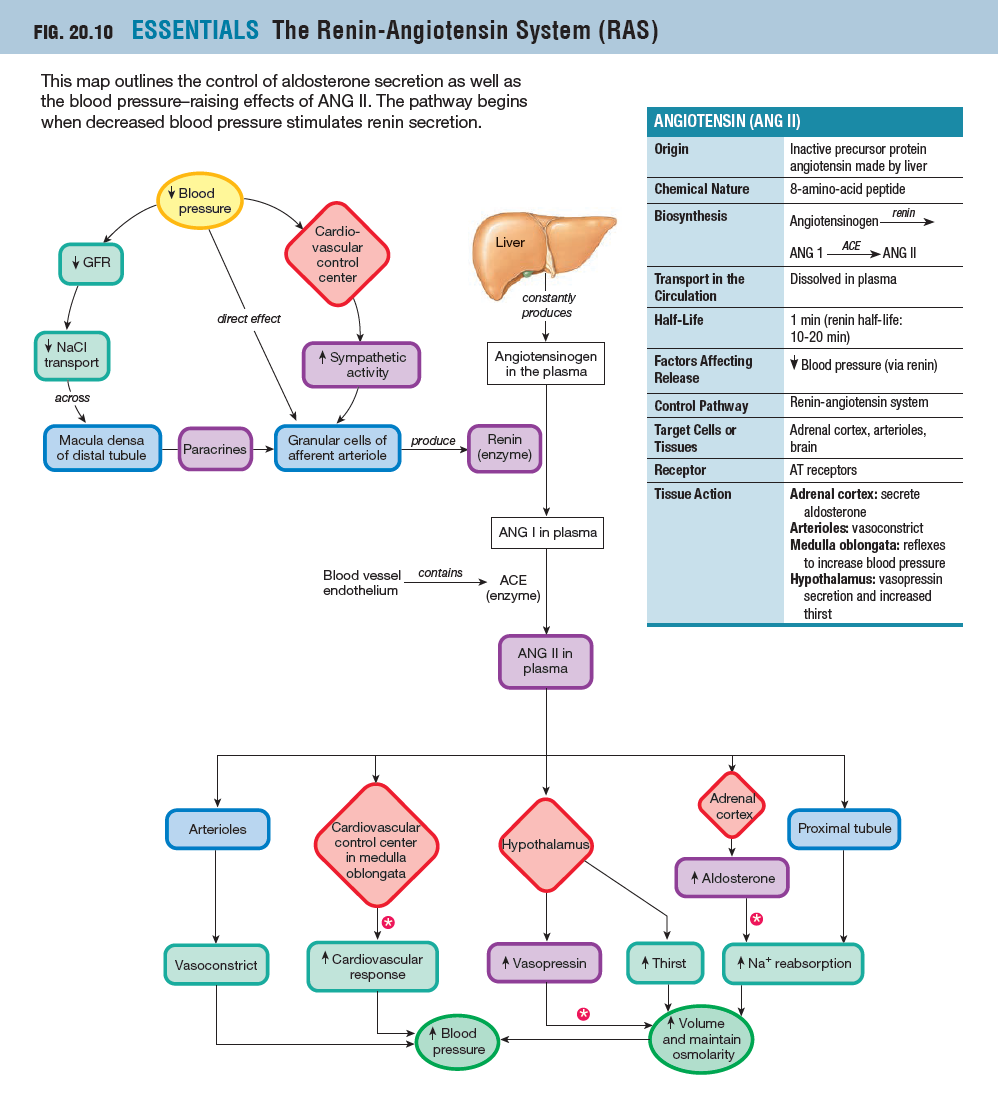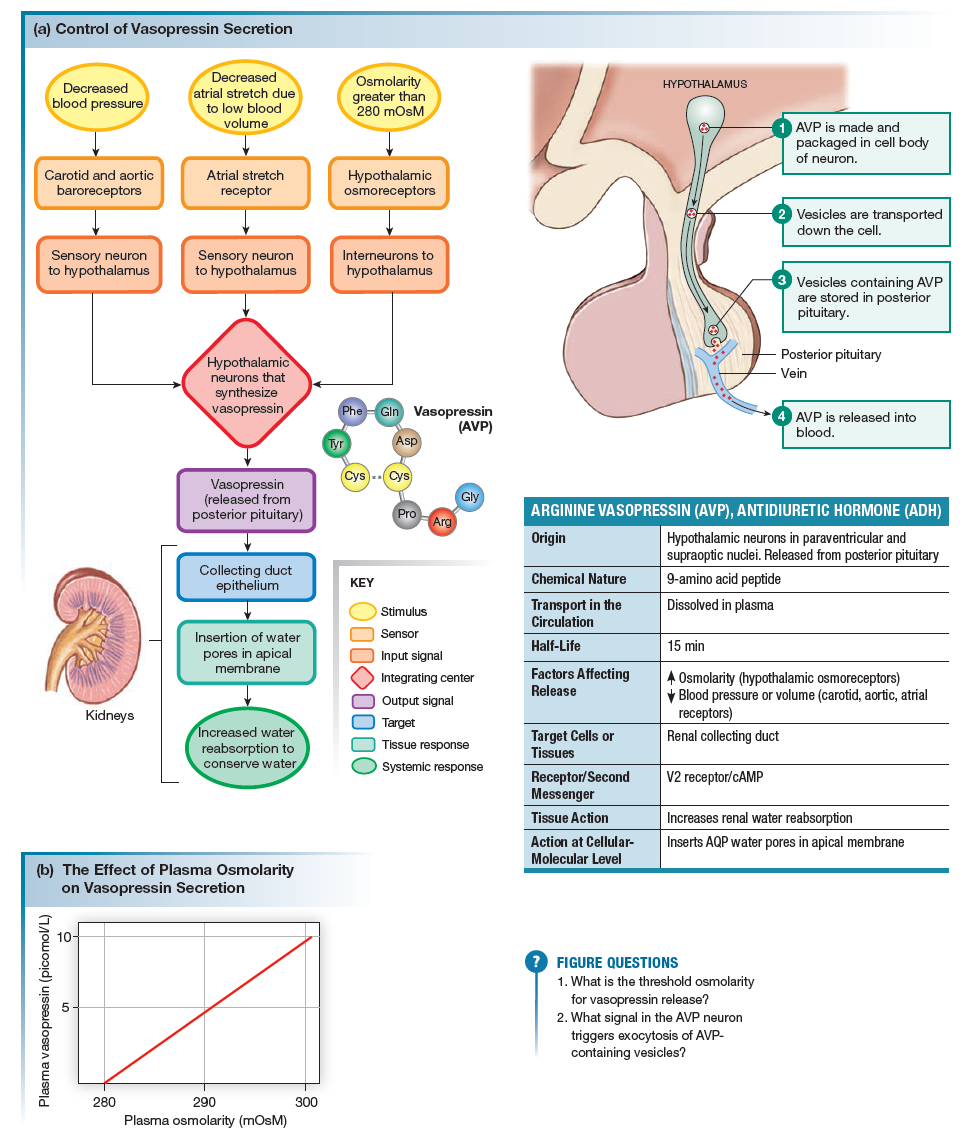Bio307 - Ch. 20 - Fluid Balance
0.0(0)
Card Sorting
1/22
Earn XP
Description and Tags
Study Analytics
Name | Mastery | Learn | Test | Matching | Spaced |
|---|
No study sessions yet.
23 Terms
1
New cards
diuresis/diuretic
water-excretion
2
New cards
aquaporin
protein that selectively allows water to pass into and out of a cell, forming pores in the membrane
3
New cards
vasopressin (ADH)
pituitary hormone that promotes the retention of water by the kidneys and increases blood pressure (aka ADH)
stimulated release when:
- blood pressure is low
- when plasma osmolarity is high
stimulated release when:
- blood pressure is low
- when plasma osmolarity is high
4
New cards
osmoreceptors
group of cells that are sensitive to plasma osmolality, regulating water balance
5
New cards
aldosterone
hormone responsible stimulating the retention of Na+ and secretion of K+ in response to low blood pressure (or hyperkalemia - excessive K+ content)
6
New cards
acidosis
higher than normal levels of acid (excessively low pH)
7
New cards
alkalosis
lower than normal levels of acid (excessively high pH)
8
New cards
renin-angiotensin system (RAS)
critical regulator of blood volume (aka blood pressure) and systemic vascular resistance: when blood pressure is detected to be low by baroreceptors, the RAS pathway is activated which stimulates release of aldosterone
associated with blood pressure regulation via modulating blood volume, sodium reabsorption, potassium secretion, water reabsorption, vascular tone
stimulates the release of aldosterone
granular cells release renin in the kidney
associated with blood pressure regulation via modulating blood volume, sodium reabsorption, potassium secretion, water reabsorption, vascular tone
stimulates the release of aldosterone
granular cells release renin in the kidney
9
New cards
Major Physiological Responses to change in blood volume/BP
Cardiovascular: vasoconstriction/vasodilation
Behavioral: thirst increases/decrease
Endocrine: ADH release control
Renal: conservation of salt and water
BP/Blood Pressure: increase/decrease
Behavioral: thirst increases/decrease
Endocrine: ADH release control
Renal: conservation of salt and water
BP/Blood Pressure: increase/decrease

10
New cards
Recognize that water always moves to the area of higher total osmolarity
...
11
New cards
Identify the major routes by which water enters and exits the body
...

12
New cards
Explain or identify how the osmolarity gradient is created in the loop of Henle
*diagram explanation*

13
New cards
Explain the mechanism by which existence of loop of Henle allows humans to concentrate urine
the ascending loop is impermeable to water, so urine becomes concentrated via the reabsorption of ions
14
New cards
Why degree to which urine can be concentrated to is equal to the osmolarity of the bottom of the loop of Henle
osmolarity wants to become equal (isosmotic)
15
New cards
Mechanism of Action of Vasopressin (when is it high/low)
aka ADH, water-retention hormone
more release when water levels are low in the body
less is released when blood pressure is higher in the body
more release when water levels are low in the body
less is released when blood pressure is higher in the body
16
New cards
Mechanism of Action of Aldosterone (when is it high/low)
the Na+ reabsorption hormone
released when blood pressure is low, or when K+ levels are high
inhibited when blood pressure is high, or K+ levels are low
released when blood pressure is low, or when K+ levels are high
inhibited when blood pressure is high, or K+ levels are low
17
New cards
The major signal mediating increased aldosterone release is the renin-angiotensin system (RAS)
ANGII is an inactive precursor made by the liver.
Release is high when blood pressure is low.
The target effect is to raise blood pressure in the body.
Acts at the adrenal cortex, arterioles, medulla oblongata, hypothalamus
Release is high when blood pressure is low.
The target effect is to raise blood pressure in the body.
Acts at the adrenal cortex, arterioles, medulla oblongata, hypothalamus

18
New cards
Predict and explain how changes in plasma osmolarity, blood volume, blood pressure affects vasopressin release
Released when plasma osmolarity is high, or when blood pressure or volume (carotid, aortic, atrial receptors)

19
New cards
Know that: Aldosterone acts at the DCT to increase Na+ concentration
...
20
New cards
Mechanism for how changes in respiratory rate changes and corrects blood pH
A higher respiratory rate causes more diffusion of gas (oxygen and carbon dioxide) which will take away carbon dioxide and introduce more oxygen, which would increase blood pH
When slowing respiratory rate, less CO2 would be exhaled which means that blood would maintain a more acidic pH (lower)
When slowing respiratory rate, less CO2 would be exhaled which means that blood would maintain a more acidic pH (lower)
21
New cards
How kidney corrects low/high blood pH
kidney has control over the reabsorption of bicarbonate via urine into blood
less HCO3 reabsorption = lower pH (compensates to shift right, which introduces more H+ acid)
more HCO3 reabsorption = higher pH (compensation to shift left, away from acid, making it more basic)
less HCO3 reabsorption = lower pH (compensates to shift right, which introduces more H+ acid)
more HCO3 reabsorption = higher pH (compensation to shift left, away from acid, making it more basic)
22
New cards
Respiratory vs Metabolic acidosis
Acidosis: pH is too low
Resp: Hypoventilation (too much CO2)
Metabolic: ex: lactic acidosis, ketoacidosis, fat/amino acid breakdown releases acid
- can result when bicarbonate is lost by diarrhea
Resp: Hypoventilation (too much CO2)
Metabolic: ex: lactic acidosis, ketoacidosis, fat/amino acid breakdown releases acid
- can result when bicarbonate is lost by diarrhea
23
New cards
Respiratory vs Metabolic Alkalosis
Alkalosis: pH is too high
Resp: Hyperventilation (deficient in CO2, which would mean equation shifts left)
Metabolic: excessive vomiting of acidic stomach content, and excessive ingestion of bicarbonate-containing antacids (decrease H+)
Resp: Hyperventilation (deficient in CO2, which would mean equation shifts left)
Metabolic: excessive vomiting of acidic stomach content, and excessive ingestion of bicarbonate-containing antacids (decrease H+)